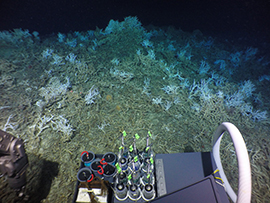Contact: Marjorie Weisskohl
703-787-1304
The fourth ocean research mission off the U.S. southeast coast begins this week as scientists depart from Charleston, S.C. on April 9 for the next phase of the DEEP SEARCH project sponsored by the Bureau of Ocean Energy Management (BOEM), the U.S. Geological Survey (USGS), and the National Oceanic and Atmospheric Administration (NOAA). Sailing aboard NOAA Ship Ronald H. Brown, the expedition will explore and characterize seeps, corals, canyons, and associated fauna along the Atlantic margin between Virginia and Georgia.
A new video captures highlights of the August 2018 expedition, including the characterization of an 85-mile stretch of Lophelia coral located 160 miles off the South Carolina coast. DEEP SEARCH is the acronym for DEEP Sea Exploration to Advance Research on Coral/Canyon/Cold Seep Habitats. Fieldwork began in 2017 under the National Oceanographic Partnership Program (NOPP).
BOEM scientists will join researchers from NOAA’s Office of Ocean Exploration and Research, USGS, Temple University, and five other academic institutions all contracted by TDI Brooks International, who are collaborating on the study. Other organizations participating in the cruise include Florida State University, Harvey Mudd College, the University of Georgia, the University of New Hampshire, and the Royal Netherlands Institute for Sea Research. In addition, Nova Southeastern University is collaborating on the study. Now in its third year of field work, the research continues to increase our knowledge of U.S. continental margin geology, the types of communities found on the seafloor, and the distribution and ecology of deepwater habitats and related mid-water communities that interact with those seafloor communities.
The upcoming mission will deploy the remotely operated vehicle (ROV) Jason for surveys, and will include ship-based multibeam mapping, CTD casts, and multicore sediment sampling at several seep targets, canyons (e.g., Keller, Pamlico, Hatteras, and unnamed canyons), and hard bottom features located between Virginia and Georgia. The Jason, designed and built by Woods Hole Oceanographic Institution with funding from the National Science Foundation, provides scientists access to the seafloor without leaving the deck of a ship to obtain live video imagery and still photos, and collect rock, sediment, water, and marine life samples.
BOEM, NOAA, and the USGS began planning the study in 2015. New information from this study could be useful in protecting the sensitive habitats that are the focus of this study if offshore resource development is planned for the region.
USGS is a multi-disciplinary science organization providing reliable scientific information to describe and understand the Earth; minimize loss of life and property from natural disasters; manage water, biological, energy and mineral resources; and enhance and protect our quality of life.
Follow DEEP SEARCH on social media at #OceanDeepSearch and on the web at https://oceanexplorer.noaa.gov/explorations/19deepsearch/welcome.html
For more information about NOAA’s Office of Ocean Exploration and Research, visit https://oceanexplorer.noaa.gov/.
For BOEM’s study profile, visit https://opendata.boem.gov/BOEM-ESP-Ongoing-Study-Profiles-2019-FYQ2/BOEM-ESP-AT-17-06.pdf
For more information on this and other USGS deep-sea coral expeditions, visit the DISCOVRE web page

